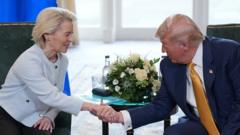The United States and the European Union have successfully negotiated a historic trade agreement, concluding a lengthy standoff that has spanned several months. After intensive discussions between President Donald Trump and European Commission President Ursula von der Leyen during a private meeting in Scotland, the two leaders have agreed on a 15% tariff on all EU products entering the US. This rate represents a significant reduction from the 30% tariffs that Trump had previously threatened.
According to Trump, the EU will reciprocate by allowing US exporters access to its markets with zero tariffs on various goods, ultimately fostering a more balanced trade relationship. Von der Leyen praised the agreement, emphasizing its potential to promote stability for both sides, which together represent nearly a third of global trade.
This deal is particularly significant as Trump has been vocal about his intention to reconfigure the global trade landscape to reduce America's trade deficit. Besides reaching an agreement with the EU, he has also established tariff arrangements with countries like the UK, Japan, Indonesia, and Vietnam, demonstrating his commitment to securing favorable trade terms.
During their meeting, which occurred at Trump's Turnberry golf resort in Scotland, the president highlighted the agreement as a victory for both parties. "It's going to bring us closer together," he remarked, underlining the collaborative effort that led to this trade breakthrough.
Von der Leyen described the negotiations as challenging, yet rewarding, and acknowledged Trump's role as a skilled negotiator. She noted that under the agreement, the EU would enhance its investment in the US by $600 billion, procure substantial amounts of American military equipment, and commit to $750 billion on energy investments. This is intended to reduce European dependency on Russian energy sources.
While both sides view the agreement positively, the trade backdrop remains complex. The EU is grateful the tariffs are not higher, especially when contrasted with other countries' trade deals, such as the UK's 10% tariff rate. Conversely, the US anticipates approximately $90 billion in tariff revenue, drawing from last year’s trade statistics.
The trade dynamics between the US and EU are pivotal, as they recorded nearly $975.9 billion in trade in goods last year. An imbalance exists, with the US importing about $606 billion from the EU and exporting around $370 billion, a discrepancy that Trump repeatedly criticizes as detrimental to the US economy.
Moreover, had higher tariffs been implemented, products ranging from Spanish pharmaceuticals to German electronics could have faced steep import taxes, potentially triggering retaliation from the EU against American goods, including significant items like car parts and aircraft.
As these developments unfold, British Prime Minister Keir Starmer is also scheduled to engage with Trump in Scotland, indicating a broader impact on transatlantic relations. Trump’s ongoing visit to Scotland has attracted attention, further amplifying the implications of international trade negotiations.




















